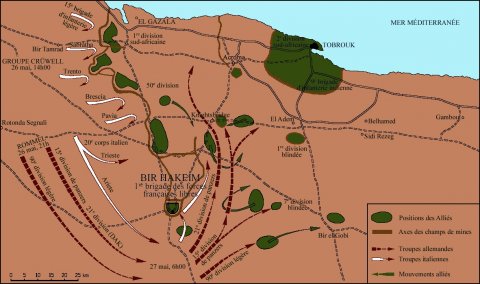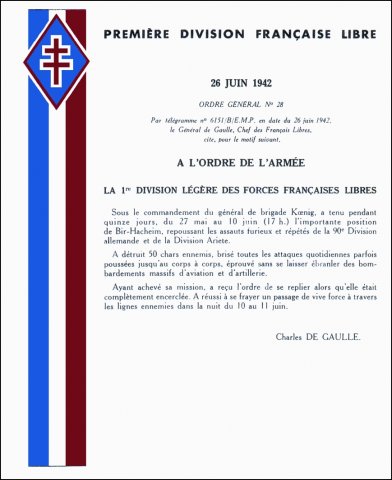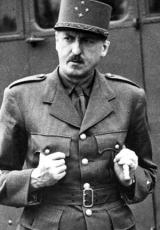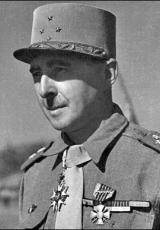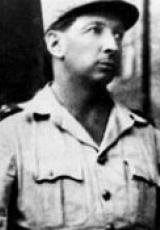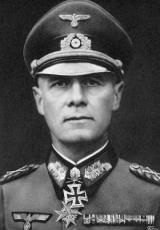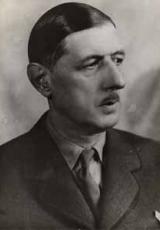The Battle of Bir Hakeim
Sous-titre
The 1st Free French Brigade against the Afrika Korps (26 May to 11 June 1942)
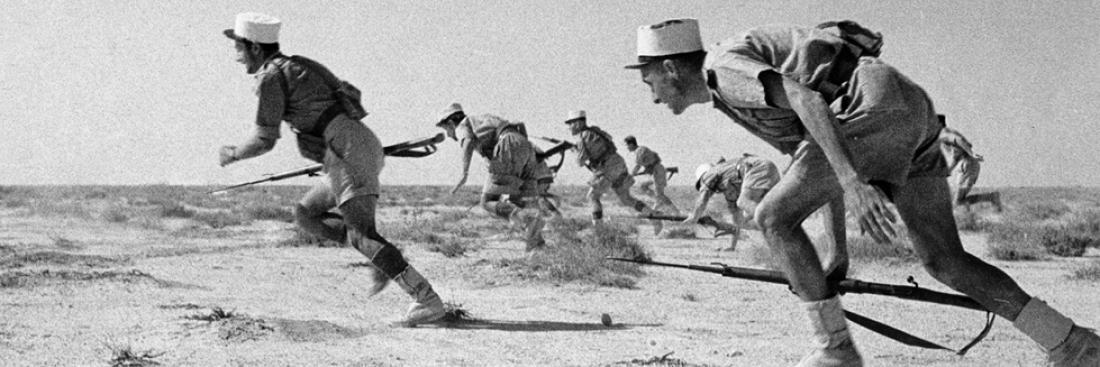
Between 26 May and 11 June 1942, the 1st Free French Brigade (1st BFL) faced the Afrika Korps and its Italian allies on the Libyan front. It did not fall back from its position at Bir Hakeim until it had secured the withdrawal of British troops.
Since September 1940, the African continent had been the scene of fierce fighting between Italians and British. From its Libyan colony, Italy sought relentlessly to conquer Egypt, then under the control of Great Britain. Crushed by British forces, the Italians received reinforcements from the Germans.
On 31 March 1941, General Rommel, in command of the Afrika Korps, launched his first offensive in Libya. Successive attacks and counter-attacks followed. By the end of 1941, British forces under General Auchinleck had won back Cyrenaica. Rommel then took the initiative once more, launching an offensive that took him as far as the port city of Tobruk, the main British base before the Egyptian border.
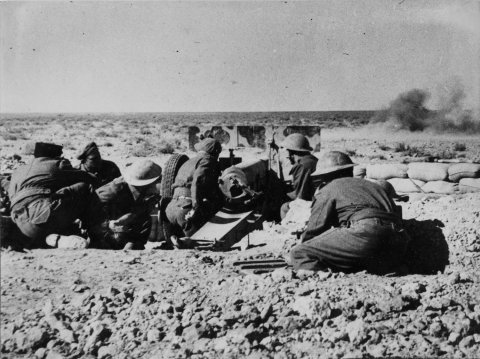
The 1st BFL on the front line. Source: Musée de l’Ordre de la Libération collection. Rights reserved
A fortified defensive camp
The British established a north-south line of resistance, held in the El Gazala sector in the north by two divisions, British and South African, and in the south by the 1st BFL, flanked to the east by the 3rd Indian Motor Brigade. Minefields stretched from one end to the other.
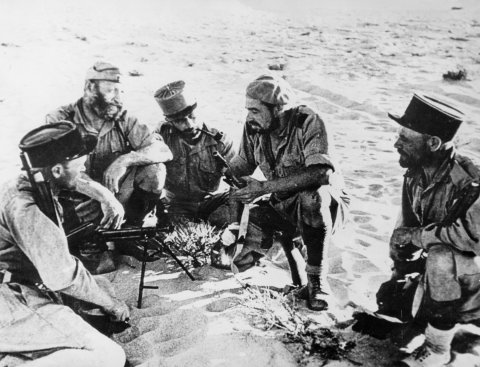
The Free French Forces hold a council of war in the desert before the Bir Hakeim attack. Source: Service Historique de la Défense
The 1st BFL’s mission was to hold the southern end of the defensive line. On the orders of General Koenig, in mid-February it took up position at Bir Hakeim, about 45 miles from the Mediterranean coast, southwest of Tobruk. Bir Hakeim was a former post of the Italian camel corps, established near a dry well on a semi-desert plateau, at the junction of a number of routes. The French position formed a triangle with a perimeter of about ten miles, with no natural defences. It was surrounded by a minefield. The French troops transformed the réduit into a fortified camp. Completing the defences begun by the British, they carried out major earthworks, digging trenches and shelters to camouflage men, weapons and vehicles.
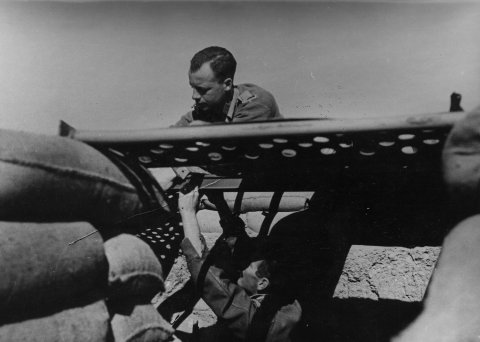
Building an individual shelter. Source: Musée de l’Ordre de la Libération collection. Rights reserved
Against the German and Italian troops, the French had 25, 47 and 75 mm anti-tank guns, Bofors 40 mm anti-aircraft guns, and 60 and 81 mm mortars, as well as sixty Bren Carrier light-armoured tracked vehicles. The force comprised two Foreign Legion battalions, one marine infantry battalion, the Pacific Battalion, the 2nd March Battalion of Ubangi-Shari, one North African company and a company of sappers. The anti-aircraft defences were reinforced by a British battery. A total of more than 3 700 men benefited from logistical support and air cover from the British.
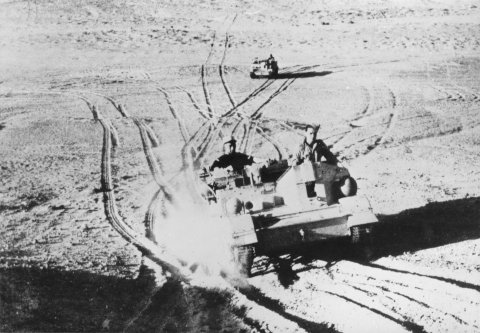
A Foreign Legion Bren Carrier on reconnaissance in the early stages of the siege, Bir Hakeim, June 1942. Source: Service Historique de la Défense
The Free French Forces (FFL) in the firing line
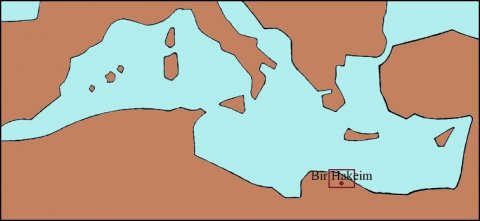
Location of Bir Hakeim. © MINDEF/SGA/DMPA/Joëlle Rosello
The Allied front in Libya and the German-Italian offensive of 26-27 May 1942. © MINDEF/SGA/DMPA/Joëlle Rosello
Click on the map to enlarge
Rommel’s plan was not to attack the Allied positions head-on, but to skirt the line of resistance to the south in order to attack the British Eighth Army from behind. On 26 May 1942, Italian units launched a diversionary attack to the north and centre of the line of resistance. The following day, the general offensive began.
While the Italians deployed their tanks on Bir Hakeim, the Germans carried out an encircling movement to skirt and isolate the position by heading north. Taking the réduit ought to have been a formality, swiftly accomplished, had it not been for the lightning response from the French. In one hour, they drove back the Italians, taking 91 prisoners and leaving thirty enemy tanks on the ground. As the Germans headed north to confront the British, the French attacked supply convoys and enemy detachments, and generally disrupted the lines of communication. Rommel, regaining the upper hand against the British, decided to stifle this pocket of resistance.
The offensive was launched on 2 June, by two divisions, one German and one Italian, supported by artillery groups and the German air force, the Luftwaffe. The French were given three successive ultimatums, in vain, on 2, 3 and 5 June.
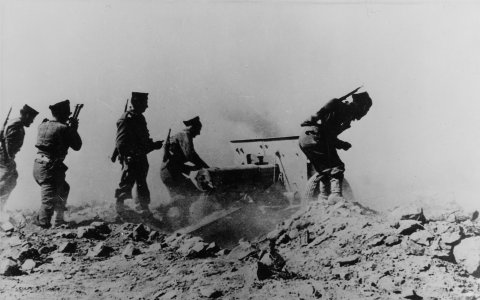
The FFL 1st Artillery Regiment at Bir Hakeim. Source: Musée de l’Ordre de la Libération collection. Rights reserved
The aerial bombardments and artillery fire intensified, but the 1st BFL held on. The situation became increasingly precarious, however, as the stranglehold tightened around Bir Hakeim. Rommel himself came to direct operations. The German-Italian attacks reached their peak on 8 to 10 June. The aircraft of the Luftwaffe swept over the position, countered by those of the Royal Air Force.
Withdrawal under enemy fire
The position was no longer tenable. With the British overwhelmed by the German advance, all resistance became useless. So Koenig ordered a general withdrawal for the night of 10 to 11 June. Under fire from the German-Italian lines, the 1st BFL made its way in force to the waiting British lorries a few miles ahead, thus escaping annihilation. It retreated to Egypt along with the British, who lost Tobruk on 21 June.
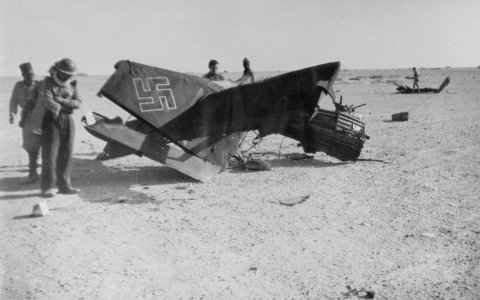
A German aircraft shot down by the French at Bir Hakeim. Source: Service Historique de la Défense
Some 2 500 men managed to get out, but those two weeks of fighting had taken a heavy toll, with over a thousand killed, wounded, missing or taken prisoner. The 1st BFL left behind 52 guns and 250 vehicles, but inflicted considerable material losses on the enemy, destroying 51 tanks, 13 armoured cars, many other vehicles and seven aircraft. It also took 123 Germans and 154 Italians prisoner.
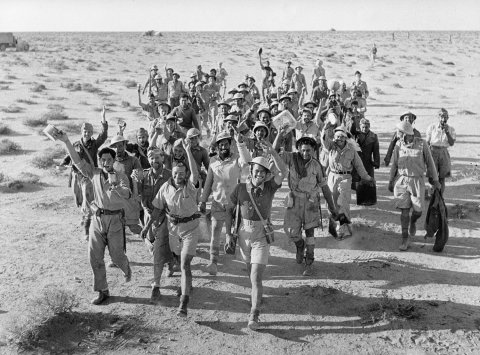
The Free French arriving at the British lines. Source: Imperial War Museum. Rights reserved.
At Bir Hakeim, the Free French were confronted for the first time with German military might, and their heroism took on symbolic value. They held out against the German-Italian forces, inflicting severe losses on them. By holding Rommel and his troops, they slowed the German advance, delayed the capture of Tobruk and, above all, enabled the British to retreat. Over the radio waves, the BBC praised the FFL’s resistance. They also made the headlines of the Allied press. On 10 June, de Gaulle sent Koenig a telegram, which read: “Be assured, and tell your troops, that you are the pride of France and all eyes are upon you.”
The 1st Free French Division
The 1st Light Division of the Free French Forces was created on 10 May 1941, at Qastina, Palestine.
It came under the orders of General Legentilhomme, and was formed of all the elements that had vowed their allegiance to Free France. These included the 13th Demi-Brigade of the Foreign Legion which, after fighting in the Norwegian Campaign, had returned to London; the 1st Marine Infantry Battalion, established in Ismailia, Egypt, in July 1940, and comprising almost the entire 3rd Battalion of the 24th Colonial Infantry Regiment, arrived from Cyprus; and a number of march battalions. Gradually, other units joined the original ones.

After the Syrian campaign in 1941, it was transformed into the “Group of Divisions of the Free French Forces”, comprised of the 1st and 2nd Light Divisions. The 1st Light Division then became the 1st Free French Mixed Brigade, which distinguished itself at Bir Hakeim in 1942, while the 2nd Light Division became the 2nd Independent French Brigade, distinguishing itself at El Alamein the same year. Comprised of elements of the Free French Forces that fought alongside British troops in Libya, the 1st Free French Division was created on 1 February 1943. In August that year, it became the 1st Motorised Infantry Division, then the 1st Infantry March Division in April 1944. To veterans, however, it will always be the 1st DFL.
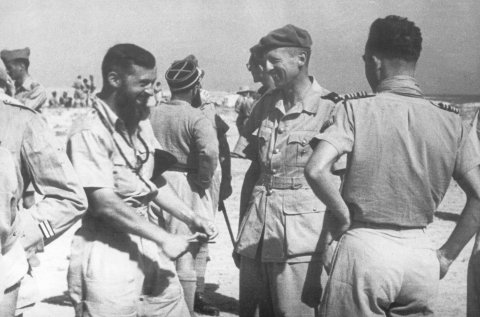
General Koenig with his senior officers in Bir Hakeim. Source: Service Historique de la Défense
Commanded successively by generals Larminat, Koenig, Brosset and Garbay, the division fought in the Tunisian (1943), Italian (1944) and French (1944-45) campaigns. It received four army citations – in June 1942 (Bir Hakeim) and January, March and July 1945 (Provence, Alsace and the Alps). The 1st DFL was dissolved on 15 August 1945.
The forces present
The Allied forces:
The British Eighth Army comprised XIII Corps (three infantry divisions, one infantry brigade and two armoured brigades) and XXX Corps (two armoured divisions, one Indian Motor Brigade and the 1st BFL), totalling 125 000 men. In direct contact with the German-Italian troops were the South African 1st Infantry Division, the British 50th Infantry Division (XIII Corps) and the 1st BFL, which was attached to the 7th Armoured Division (XXX Corps). The 1st BFL consisted of 5 500 men: the front-line troops dug in at Bir Hakeim and the units installed 15 miles further east. The British fielded some 750 tanks and 700 aircraft.
The German-Italian forces:
The Germans fielded three divisions – the 15th and 21st Armoured Divisions and the 90th Light Division; the Italians two divisions of XX Corps (the “Ariete” armoured division and the “Trieste” motorised division), together with the “Sabratha”, “Trento” (XXI Corps), “Brescia” and “Pavia” (X Corps) divisions, for a total of 113 000 men. The German-Italian forces had 570 tanks and 500 aircraft.
Not counting air cover, the comparative armies at Bir Hakeim were 3 723 men, equipped with a hundred 25 to 75 mm guns, for the Free French, against 37 000 men with two hundred and seventy 75 to 210 mm guns and 350 tanks for the German-Italian forces (source: Musée de l’Armée).
Key dates:
17 June 1940: France requests an armistice; General de Gaulle leaves for London.
18 June 1940: General de Gaulle issues his call to arms.
22 June 1940: Franco-German armistice signed at Rethondes.
24 June 1940: Franco-Italian armistice signed in Rome.
28 June 1940: General de Gaulle is recognised by Great Britain as the leader of the Free French.
26-30 August 1940: Chad, Cameroon, Middle Congo and Ubagni-Shari declare their support for Free France.
12 September 1940: The Italian offensive in Egypt.
23-25 September 1940: Failure of the Anglo-Gaullist attempt off Dakar to rally French West Africa to Free France.
27 October to 12 November 1940: Gabon occupied by the Free French Forces.
9 December 1940: British offensive in Libya (Operation Compass).
19 January to 20 May 1941: Allied offensive in Italian East Africa.
23 January 1941: British capture of Tobruk.
12 February 1941: Arrival of General Rommel, followed by the first units of the Deutsche Afrika Korps (on the 14th) at Tripoli.
1 March 1941: Capture of Kufra by Leclerc’s Free French.
31 March to 29 April 1941: German-Italian offensive in Libya.
8 June to 14 July 1941: Anglo-Gaullist campaign in Syria.
18 November to 30 December 1941: British offensive in Libya (Operation Crusader).
14 February 1942: Arrival of 1st BFL at Bir Hakeim.ye.
14 février 1942 : Arrivée de la 1re BFL à Bir Hakeim.
Late February to 14 March 1942: Leclerc carries out a successful offensive on Fezzan.
26 May 1942: German-Italian offensive launched on the Gazala front.
26 May to 11 June 1942: The Battle of Bir Hakeim.
21 June 1942: German capture of Tobruk.
The 1st DFL’s army citation of 26 June 1942
Click on image to enlarge


